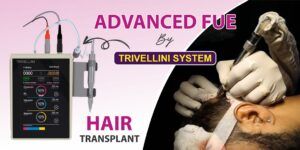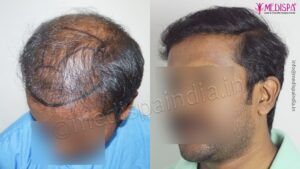
Hair loss from an early age does a great deal to undermine confidence and personal image. Advances in medical science have enabled hair transplant procedures to become a trusted solution for many patients with baldness or thinning hair. Among them, FUE Hair Transplant (Follicular Unit Extraction) is the most preferred one due to its minimally invasive nature, natural-looking results, and very fast recovery time.
Over the years, traditional FUE methods have evolved into more advanced procedures that rely on precision instruments, digital systems, and robotic assistance for better accuracy, graft survival rates, and cosmetic outcomes. Let’s understand what makes the Advanced FUE Hair Transplant a true paradigm shift in modern hair restoration and how these advantages make choosing this procedure so appealing.
1. Minimally Invasive & Almost Scar-Free
One of the primary benefits of the advanced FUE technique is that it does not require any large incisions or stitches. The tissue is minimally affected by using ultra-fine punches to extract individual hair follicles, leaving behind very small, round scars that are almost invisible to the naked eye. This keeps it ideal for individuals who wear shorter hairstyles or individuals with concerns regarding visible scarring.
Sutures are unnecessary; hence, the post-operative wound healing is rather quick and virtually painless, leaving an incredibly low risk factor for infection as compared to the classic strip method (FUT).
2. Fast Recovery
Because it is minimally invasive, recovery after advanced FUE is much faster. Most patients return to their daily routine within 3–5 days, while the absence of stitches and linear scarring provides extra comfort during wound healing.
This works well for working professionals who may not be able to afford extended time off the job. It also helps minimise the possibility of ever-increasing complications that would hinder healing.
3. Maximum Precision and Natural Results
The latest advances in FUE make use of improvements in technology for enhanced precision by means of methods like stereomicroscopic extraction, robotic systems, and ultra-high resolution imaging. Those improvements allow the surgeon to extract quality grafts while minimising transection (damage) and planning better for placing the follicles at the right angle, direction, and density.
With that much effort into it, the patients are left with a natural-looking hairline that seamlessly matches the existing hair. Anyone could hardly tell that a transplant was done, which for many clients is probably the most important consideration.
4. Less Pain During and After Surgery
Advanced FUE is usually performed under local anaesthesia and is, therefore, almost painless. Because there are no big cuts, postoperative pain is also minimal. Patients usually feel only mild soreness or tightness around the donor site for a few days, easily relieved with over-the-counter drugs.
Just based on comfort, the procedure has more attractiveness than the older techniques, particularly among people who tend to be worried about surgical pain or long down times.
5. Perfect for Small or Specific Areas
Advanced FUE allows for the treatment of localised hair loss scenarios like temple recession, widow’s peak restoration, beard or eyebrow reconstruction, and even corrective procedures for past transplant scars. It allows highly precise extraction of a few grafts from several body areas, among them the beard or chest (if the scalp donor is not very good), thereby affording excellent precision.
That precision gives both patient and surgeon total control over targeted zones, particularly with those who do not need full-head coverage yet would like to add density in certain areas.
6. Best Donor-Hair Preservation
In FUE, grafts are extracted randomly from the donor area, helping maintain uniform hair density even after the procedure. This ensures that the donor site will not clinically appear to be thinning, an important consideration for patients undergoing multiple sessions or those with a scarce donor profile.
The advanced methods, too, optimise the number of each session’s viable grafts while impacting the success-per-graft ratio favourably and preserving the donor supply for future needs.
7. Flexibility in Repeat Sessions
Patients needing more than one session, either due to progressive hair loss or wishing for increased density, might find advanced FUE particularly comfortable. There are no large surgical scars or repeated trauma distortion of the donor area, further enabling future harvesting without compromising the aesthetics or safety.
This way is especially favourable to younger patients, some of whom may experience ongoing hair absence in the Years ahead and therefore may also need touch-up procedures.
8. Transparent and Variable Costing
Frequently, one of the queries that people have for themselves concerns hair transplant cost in India. Charges for advanced FUE are usually per-graft. This transparency allows patients to make a budgetary plan of their own according to how many grafts were estimated to be needed during consultation.
While hair transplant cost in India for advanced FUE may be a little higher compared to traditional methods, the advantages of faster recovery, natural results, and minimal scarring would convince most of them to do so.
Conclusion
Did you think of a solution that would last the rest of your life? Then, FUE Hair Transplant, especially the advanced versions, is your best bet. With precision, aesthetics, patient comforts, and a rapidly resolving nature, it is changing the entire hair restoration surgery scenario.
Like in every other medical treatment, success depends on the skills of the surgeon and the standard of the clinic. Ensure to choose one centre with a good reputation, providing up-to-date technology for all treatments, transparent conduct for all procedures, and expert professionals for achieving the best results.
The journey of restoring your hair deserves your prudent consideration, so take sufficient time to research and consult.







